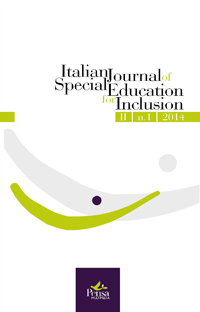Traiettorie non lineari della ricerca didattica: le potenzialità metaforiche ed inclusive delle corporeità didattiche
Abstract
A rich scientific literature confirms that gestures are an expression of embodied knowledge able to express additional meanings which go beyond the perimeter of speech and writing (Hostetter & Alibali 2008; Gibbs, 2006; R. Lakoff & Núñez, 2005). According to research directed by Alain Berthoz, “nos pensées, le development de nos fonctions cognitives les plus élevées et meme les plusabstraites avaient leur fondement dans le corps en acte” (Berthoz, 2009)1. In this context, the use of the body in movement in didactics can be considered, from a methodological point of view, a
potential deviation, that is a complex additional strategy (Berthoz, 2011) to face the formative complexity (Sibilio, 2013). In this sense, the corporeality represents all the opportunities offered
by the body and movement to foster teaching- learning process through inclusive modality of action, stimulating every possible use of different abilities of students.
In this perspective, the spatio-motor programs executed with the hands are congruent with the spatio-motor schemas underlying word meanings. (Casasanto & Lozano, 2006) and confirm the
concept of motor equivalence: “on désigne par ‘équivalence motrice’ une propriété simple et remarquable du cerveau: celle qui permet de faire le même mouvement avec des effecteurs très différents. Par exemple, je peux écrire le lettre A avec le main, ou le pied, ou même la bouche; je peux même dessiner un A en me promenant sur le plage!” (Berthoz, 2013; Berthoz, 2009).
The research hypothesis proposed in this paper is set up as a non-linear educational research trajectory that tries to harmonize Berthoz’ theoretical approach on simplexity with the scientific contributions of George Lakoff and Mark Johnson (Lakoff & Johnson, 1997) on the metaphorical nature of the conceptual system in the field of education.
The aim of this research is to validate in the teaching-learning process the use of the body in movement and its possible metaphorical dimension, as an educational methodological opportunities in an inclusive perspectives that can foster the acquisition of spatial concepts.
Downloads
Published
2014-11-04
Issue
Section
III. ESITI DI RICERCA (a. ricerca qualitativa e quantitativa; b. Strumenti e metodologie)


